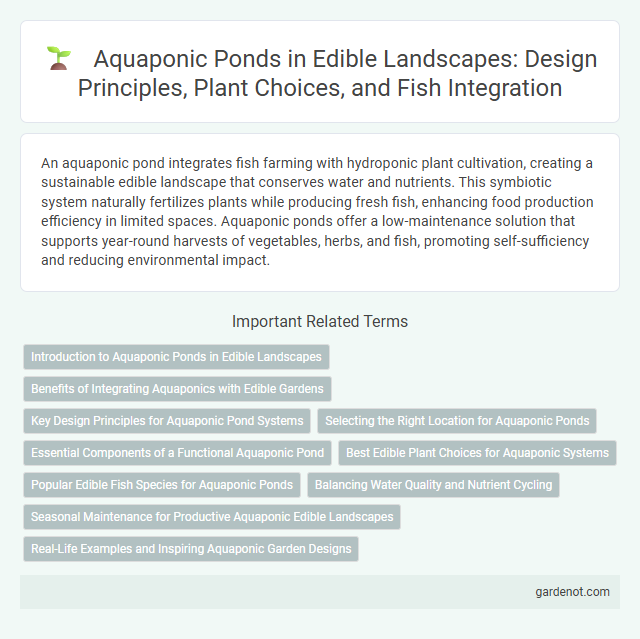An aquaponic pond integrates fish farming with hydroponic plant cultivation, creating a sustainable edible landscape that conserves water and nutrients. This symbiotic system naturally fertilizes plants while producing fresh fish, enhancing food production efficiency in limited spaces. Aquaponic ponds offer a low-maintenance solution that supports year-round harvests of vegetables, herbs, and fish, promoting self-sufficiency and reducing environmental impact.
Introduction to Aquaponic Ponds in Edible Landscapes
Aquaponic ponds combine aquaculture and hydroponics to create sustainable, self-sufficient ecosystems ideal for edible landscapes. These systems recycle nutrient-rich water from fish tanks to nourish plants, reducing the need for chemical fertilizers while promoting healthy plant growth and fish production. Incorporating aquaponic ponds enhances food diversity and maximizes space efficiency in urban and residential gardens.
Benefits of Integrating Aquaponics with Edible Gardens
Integrating aquaponic ponds with edible gardens enhances sustainable food production by combining fish farming and hydroponic plant cultivation, resulting in nutrient-rich water that naturally fertilizes crops. This symbiotic system reduces water usage by up to 90% compared to traditional farming and eliminates the need for chemical fertilizers, promoting organic growth of vegetables, herbs, and fruits. Aquaponics also increases yield density in limited spaces, making it ideal for urban edible landscapes seeking efficient, eco-friendly food solutions.
Key Design Principles for Aquaponic Pond Systems
Key design principles for aquaponic pond systems include maintaining optimal water quality by monitoring pH levels between 6.8 and 7.2 and ensuring efficient filtration to support both fish health and plant growth. Incorporating proper aeration and circulation creates an oxygen-rich environment essential for nutrient exchange and biological balance. Designing for scalability and easy access to sunlight supports sustainable crop production and fish biomass in edible landscapes.
Selecting the Right Location for Aquaponic Ponds
Choosing the right location for aquaponic ponds plays a critical role in optimizing fish growth and plant health within an edible landscape. Opt for an area with consistent sunlight exposure of at least 6-8 hours daily, access to clean water sources, and protection from strong winds or extreme temperature fluctuations to maintain pond stability. Proximity to utilities such as electricity and drainage systems enhances system efficiency and ease of maintenance.
Essential Components of a Functional Aquaponic Pond
A functional aquaponic pond integrates essential components such as a biofilter to convert fish waste into nutrients, a grow bed for plants to absorb these nutrients, and a water pump to circulate oxygenated water between fish and plants efficiently. Maintaining optimal water temperature, pH levels, and dissolved oxygen is critical for balancing the ecosystem and promoting healthy growth of both aquatic life and vegetation. The synergy of nitrifying bacteria, nutrient-rich water, and proper filtration ensures sustainable food production in an edible landscape.
Best Edible Plant Choices for Aquaponic Systems
Leafy greens such as lettuce, spinach, and kale thrive in aquaponic ponds due to their fast growth and high nutrient uptake, making them ideal for maximizing system efficiency. Herbs like basil, mint, and cilantro also perform well, benefiting from the nutrient-rich water while enhancing flavor and diversity in an edible landscape. Fruit-bearing plants such as strawberries and cherry tomatoes are excellent choices for aquaponic systems, as they adapt to aquatic environments and contribute valuable variety to home garden yields.
Popular Edible Fish Species for Aquaponic Ponds
Tilapia, catfish, and koi are among the most popular edible fish species for aquaponic ponds due to their adaptability and high growth rates. These fish thrive in controlled aquatic environments, efficiently converting feed into protein while supporting plant growth through nutrient-rich water. Incorporating species like barramundi and trout can diversify production, each requiring specific temperature and oxygen conditions to optimize yield in aquaponic systems.
Balancing Water Quality and Nutrient Cycling
Maintaining optimal water quality in an aquaponic pond is essential for supporting both fish health and plant growth, relying on a balanced nutrient cycling process that converts fish waste into vital nutrients. Efficient biofiltration ensures ammonia from fish waste is transformed into nitrates, which plants utilize, thereby preventing toxic buildup and promoting a sustainable ecosystem. Continuous monitoring of pH, dissolved oxygen, and nutrient levels enables precise adjustments that stabilize the aquaponic system, maximizing productivity in an edible landscape.
Seasonal Maintenance for Productive Aquaponic Edible Landscapes
Seasonal maintenance of an aquaponic pond in edible landscapes involves monitoring water temperature, pH levels, and nutrient balance to ensure optimal plant growth and fish health throughout the year. Regular cleaning of filters, removal of organic debris, and adjustment of fish feeding schedules align with seasonal changes to prevent disease and promote productivity. Implementing preventive measures during colder months, such as insulating the pond or introducing heat sources, sustains the aquaponic system's efficiency and crop yields.
Real-Life Examples and Inspiring Aquaponic Garden Designs
Aquaponic ponds enhance edible landscapes by integrating fish cultivation with organic plant growth, exemplified by innovative projects like the Self-Sustaining Aquaponic Farm in Singapore, which combines tilapia farming with vegetable production, maximizing space and resources. Urban gardens, such as the Backyard Aquaponics System in Portland, use fish waste to nourish hydroponic plants, creating a closed-loop ecosystem that produces fresh herbs, lettuces, and edible flowers year-round. These designs inspire sustainable food production by demonstrating how aquaponic ponds can transform small-scale home gardens into productive, eco-friendly edible landscapes.
Aquaponic pond Infographic

 gardenot.com
gardenot.com